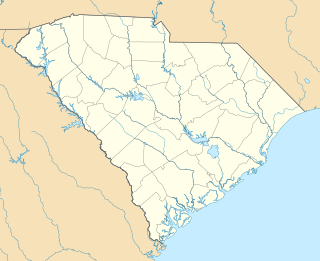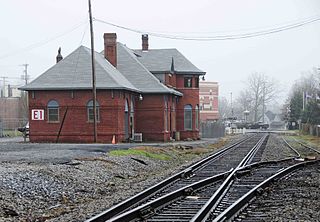
The Dillon County Courthouse, built in 1911, is a historic courthouse located at 301 West Main Street in the city of Dillon in Dillon County, South Carolina. It was designed in the Classical Revival style by Darlington native William Augustus Edwards who designed eight other South Carolina courthouses as well as academic buildings at 12 institutions in Florida, Georgia and South Carolina. Dillon County was created in 1910 and this is the only courthouse it has ever had. On October 30, 1981, it was added to the National Register of Historic Places. It is located in the Dillon Downtown Historic District.
William Augustus Edwards, also known as William A. Edwards was an Atlanta-based American architect renowned for the educational buildings, courthouses and other public and private buildings that he designed in Florida, Georgia and his native South Carolina. More than 25 of his works have been listed on the National Register of Historic Places.

This is a list of items on the National Register of Historic Places listings in Darlington County, South Carolina.

Great Falls Downtown Historic District is a national historic district located at Great Falls, Chester County, South Carolina. The district encompasses 14 contributing buildings in the central business district of Great Falls. They were built between about 1910 and 1930, and consist of the buildings constructed by the Republic Textile Mills Company to provide a commercial area to meet the needs of the mill workers and their families.

Manning Commercial Historic District is a national historic district located at Manning, Clarendon County, South Carolina. The district encompasses 46 contributing buildings and 1 contributing object in the central business district of Manning, county seat for Clarendon County. Manning's downtown is dominated by its 1909 Neo-Classical, red brick courthouse set at the center of a landscaped courthouse square. The commercial district is characterized by one- and two-part commercial block buildings, many of them brick, that were constructed during the late-19th and early-20th century. The buildings are characterized by oblique and angled entrances, intriguing decorative cornices and corbeling, and a preponderance of parapeted rooflines give the Manning Commercial Historic District a clear and unmistakable association with the architecture typical of the early-20th century. In addition to the courthouse, other notable buildings include the U.S. Post Office and Federal Building, Coffey-Rigby Livery Stable, Clarendon Furniture Store, Leonard Building, Manning Hotel, Brailsford Grocery / Schwartz Building, Cut Rate Drug Store, and Pure Oil Service Station.

Cashua Street–Spring Street Historic District is a national historic district located at Darlington, Darlington County, South Carolina. The district encompasses 39 contributing buildings in a residential section of Darlington. The district includes a significant collection of intact residences constructed between about 1890 and 1930. Many of the homes were owned by prominent Darlington citizens. The residences along Cashua Street are large, two-story frame dwellings while the residences along Spring Street are smaller, one-story frame houses. Most of the residences have decorative woodwork and are significant examples of the builder's art. Architectural styles include Victorian, Queen Anne, Colonial Revival, and Bungalow. The buildings are situated on large lots that are planted with trees and shrubs.

Darlington Industrial Historic District is a national historic district located at Darlington, Darlington County, South Carolina. The district encompasses 12 contributing buildings and 1 contributing structure in an industrial section of Darlington. They were built between about 1890 and 1925. All of these buildings are located along the rights-of-way of the South Carolina Western Railway and the Charleston, Sumter and Northern Railroad since the industries each of these buildings served employed the services of the railroad. Among the prominent resources in the district are the Charleston, Sumter and Northern Railway Freight Station (1891), the Darlington Roller Mill (1899), Thomas and Howard Tobacco Warehouse ; and Price's Tobacco Warehouse, and a cotton warehouse.

Oaklyn Plantation is a historic plantation and national historic district located near Darlington, Darlington County, South Carolina. The district encompasses 40 contributing buildings, 6 contributing sites, 2 contributing structures, and contributing object. Founded as a forced-labor farm worked by black people enslaved by the land's white owners, it was one of the major plantation establishments of the county and served as the seat of the Williamson family for more than 200 years.

St. John's Historic District is a national historic district located at Darlington, Darlington County, South Carolina. The district encompasses 55 contributing buildings and 1 contributing site in a mixed residential section of Darlington. The focal point of the district is St. John's School complex and campus, the Academy Green. The properties in the district are located in approximately five block area of oak lined streets. Approximately 75 percent of the buildings were constructed prior to 1925. Most of them were built between 1880 and 1925 during a period of unprecedented agricultural prosperity and reflect the architectural characteristics of that era, including Queen Anne, Neo-Classical, Colonial Revival, and Bungalow. Notable buildings include Central Baptist Church, Darlington County Library, St. John's High School, St. John's Elementary School, Open-Air Theatre, Haynesworth House, L. S. Welling House, and Trinity Methodist Episcopal Church.

West Broad Street Historic District is a national historic district located at Darlington, Darlington County, South Carolina. The district encompasses 36 contributing buildings in a primarily residential section of Darlington. They were constructed between about 1890 and 1928. Most of the residences are grand in scale and reflect the prosperity of the individuals who built them. Several of the houses were owned by some of Darlington's most prominent citizens. Most of the residences are large, two-story frame Victorian or Queen Anne structures with decorative woodwork. The dwellings are set on deep lots that are planted with large trees and shrubs. A number of these large residences are similar in appearance and were built by master carpenter Lawrence Reese. Also included in the district are 13 modest, one-story frame houses with a few decorative features, as well as two imposing brick bungalows.

East Home Avenue Historic District is a national historic district located at Hartsville, Darlington County, South Carolina. The district encompasses 52 contributing buildings and 1 contributing site in a primarily residential section of Hartsville. They were constructed between about 1890 to about 1938, and is associated with the leading figures of the town's history. Home Avenue has historically been the major residential street in Hartsville since it was laid out and landscaped in 1890. Architectural styles and influences include Renaissance Revival, Colonial Revival, Classical Revival, American Craftsman, and Bungalow. Notable non-residential buildings include the First Baptist Church, Thornwell Elementary School, and Hartsville Public School. Located in the district is the separately listed John L. Hart House.

West College Avenue Historic District is a national historic district located at Hartsville, Darlington County, South Carolina. The district encompasses 22 contributing buildings in a primarily residential section of Hartsville. They were constructed between about 1906 to about 1930, with the majority constructed between 1910 and 1926. They illustrate a period of significant development which saw the town's population increase more than five times its size at the turn of the 20th century. The architecture reflects late-19th and early-20th century movements such as Victorian, Queen Anne, Colonial Revival, and Bungalow.

Lawton Park and Pavilion is a historic public park and national historic district located at Hartsville, Darlington County, South Carolina. The district encompasses two contributing buildings built 1939-1941 by the Works Progress Administration, and planned as early as 1938. The park is a wooded, 3.5 acre, public recreation area including a swimming area, playground, picnic area, and tennis courts. The park includes three buildings: a Colonial Revival style pavilion, shed and keeper's house.

The Manne Building is a historic commercial building located at Darlington, Darlington County, South Carolina.

J.L. Coker Company Building is a historic commercial building located at Hartsville, Darlington County, South Carolina. It was designed by Charles Coker Wilson and built in 1909–1910. It is a one-story, 11-bay, brick building with a brick warehouse addition. The building covers an area of approximately one acre. The façade consists of an arcade whose segmental arches enclose the display bays and entrances. It was built for the company founded by Major James Lide Coker. It is currently the home of the Hartsville YMCA.

Orangeburg Downtown Historic District is a national historic district located at Orangeburg, Orangeburg County, South Carolina. The district encompasses 44 contributing buildings in the central business district of Orangeburg. It includes a variety of commercial, industrial, and governmental buildings built between about 1883 and 1925. Notable buildings include St. Paul's Methodist Church, U. S. Post Office, Blythewood Building, Orangeburg City Hall, and Fire Department Headquarters.

Union Downtown Historic District is a national historic district located at Union, Union County, South Carolina. The district encompasses 48 contributing buildings in the central business district of Union. The commercial, public, residential, industrial, and transportation-related buildings were built between about 1878 to about 1940, with the majority dating from about 1880 to about 1930. The district includes buildings representative of the Neo-Classical and Victorian styles. Notable buildings include the Union County Courthouse, Union Post Office/Federal Building, Flynn Building, Krass Building, People's State Bank/Arthur State Bank, Union Depot, Union Cotton Oil Mill, and Union Hardware Co. Located in the district is the separately listed Fair Forest Hotel.

Clover Downtown Historic District is a national historic district located at Clover, York County, South Carolina. It encompasses 14 contributing buildings in the central business district of Clover. The buildings are predominantly one to three-story masonry commercial buildings built between the mid-1880s and about 1935.

Sharon Downtown Historic District is a national historic district located at Sharon, York County, South Carolina. It encompasses nine contributing buildings in the central business district of Sharon. The buildings are predominantly masonry commercial buildings built between 1908 and 1944. The buildings are the First National Bank of Sharon, Shannon and Plexico Buildings, Love and Kennedy Buildings, Hope Building and Sims Hood Drugstore, and John S. Rainey Cotton Gin, Seedhouse and Office.

West End Commercial Historic District is a national historic district located at Greenville, South Carolina. It encompasses 15 contributing buildings in Greenville's second "downtown." The commercial buildings primarily date from about 1880 to 1920, and include examples of Victorian commercial architecture. Notable buildings include the American Bank, Alliance and Mills & McBayer Cotton Warehouses, Indian River Fruit Store, Pete's Place, Bacot's West End Drug Store/Stringer's Drug, Furman Lunch, and Greer Thompson Building.



















